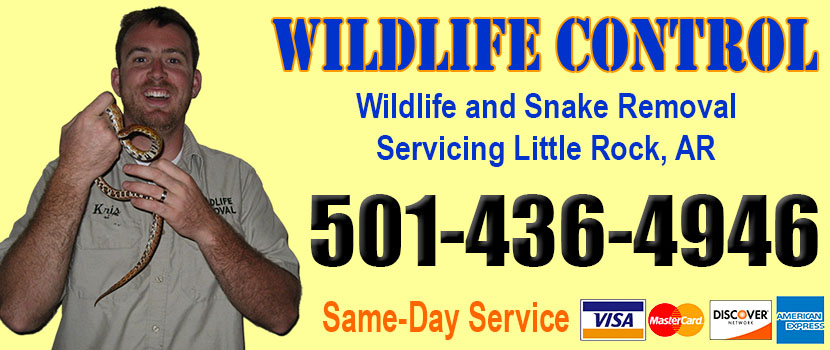
Welcome to littlerocksnakes.com! I am David, a snake enthusiast living in Little Rock, AR. Many people don't know that Little Rock is in fact full of snakes! You just need to know where to find them - they can often be shy and elusive. Some Arkansas snake species are more common outside of the city limits, in different parts of Pulaski County AR, but many types of snakes are indeed common in the more urban parts of Little Rock. This guide is meant to help educate you about the beautiful snakes of Little Rock, and to help you identify the most common snakes of Little Rock, as well as the venomous snakes of Little Rock that you should learn to recognize and avoid. If you want more detail, click here for my complete list of ALL snake species in Little Rock. Remember the following:
- Most snakes of Little Rock are harmless and don't want to encounter you
- Venomous snakes exist but are uncommon in Little Rock, Arkansas
- Snakes eat rats and mice and are a valuable part of the Arkansas ecosystem
- Never kill a snake - if you leave a snake alone, it will leave you alone.
Common Snake Species in Little Rock
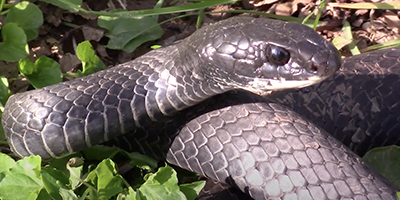 Eastern Racer:
Also known as the Coluber constrictor, the eastern racer is a non-venomous, exceptionally fast type of snake you can encounter in Arkansas. It typically grows up to 60 inches (150 cm) in length and is usually one solid color (rather than multiple shades), like black or brown. It’s a largely diurnal serpent, and its diet primarily consists of small rodents, lizards, and any other creature it can overpower.
Eastern Racer:
Also known as the Coluber constrictor, the eastern racer is a non-venomous, exceptionally fast type of snake you can encounter in Arkansas. It typically grows up to 60 inches (150 cm) in length and is usually one solid color (rather than multiple shades), like black or brown. It’s a largely diurnal serpent, and its diet primarily consists of small rodents, lizards, and any other creature it can overpower.
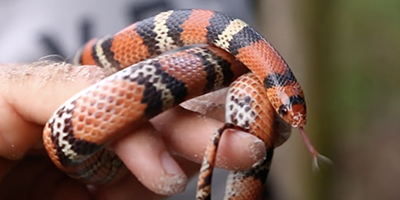 Northern Scarlet Snake:
Scientifically referred to as the Cemophora coccinea copei, the northern scarlet snake is a small type of serpent, usually only measuring 20 inches (or roughly 50 cm) in length. It’s a secretive, burrowing snake that spends most of its time hidden, usually only emerging to capture prey (e.g. small lizards and rodents). Its body is usually white or gray and speckled with reddish blotches.
Northern Scarlet Snake:
Scientifically referred to as the Cemophora coccinea copei, the northern scarlet snake is a small type of serpent, usually only measuring 20 inches (or roughly 50 cm) in length. It’s a secretive, burrowing snake that spends most of its time hidden, usually only emerging to capture prey (e.g. small lizards and rodents). Its body is usually white or gray and speckled with reddish blotches.
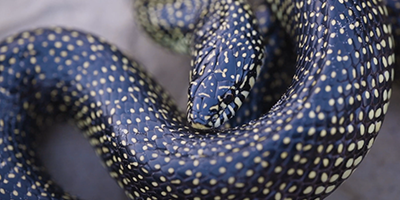 Speckled Kingsnake:
Or Lampropeltis holbrooki, by its official name. The speckled kingsnake is a fairly long serpent, usually growing to roughly 50 inches (or around 120 cm). True to its name, its body is mainly black and marked by bright yellow specks, which make it easily recognizable. It tends to issue a rattling noise when threatened, hoping to imitate a venomous rattlesnake. The speckled kingsnake usually dwells in wet areas, like swamps, and feeds on small mammals and rodents. Its docile nature makes it a quite common pet.
Speckled Kingsnake:
Or Lampropeltis holbrooki, by its official name. The speckled kingsnake is a fairly long serpent, usually growing to roughly 50 inches (or around 120 cm). True to its name, its body is mainly black and marked by bright yellow specks, which make it easily recognizable. It tends to issue a rattling noise when threatened, hoping to imitate a venomous rattlesnake. The speckled kingsnake usually dwells in wet areas, like swamps, and feeds on small mammals and rodents. Its docile nature makes it a quite common pet.
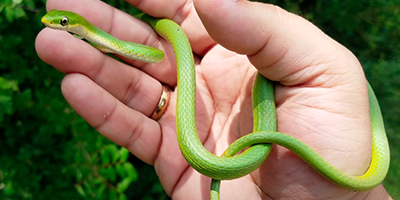 Rough Green Snake:
The rough green snake (or the Opheodrys aestivus) is true to its name, usually easily distinguished by its bright green color, and usually has a yellowish belly. It’s a fairly big snake, growing up to 45 inches (115 cm), but is remarkably thin, which makes it difficult to see in the grass. It’s a highly docile serpent, which makes it one of the easiest snakes to approach. It’s an excellent climber and can often be found in trees, usually near water. Its diet usually consists of insects, snails, and small frogs.
Rough Green Snake:
The rough green snake (or the Opheodrys aestivus) is true to its name, usually easily distinguished by its bright green color, and usually has a yellowish belly. It’s a fairly big snake, growing up to 45 inches (115 cm), but is remarkably thin, which makes it difficult to see in the grass. It’s a highly docile serpent, which makes it one of the easiest snakes to approach. It’s an excellent climber and can often be found in trees, usually near water. Its diet usually consists of insects, snails, and small frogs.
Venomous Snake Species in Little Rock
 Copperhead:
Officially referred to as the Agkistrodon contortrix, the copperhead is a type of pit viper that typically grows up to 37 inches (or roughly 90 cm in length). It is distinguished by its head, which is usually broader than the body, and by its earthy color palette. The copperhead is marked by 10 - 18 crossbands that resemble an hourglass in shape, and are slightly darker than the body. Its eyes are elliptical, and its diet consists mainly of small rodents. It usually lives in forested areas.
Copperhead:
Officially referred to as the Agkistrodon contortrix, the copperhead is a type of pit viper that typically grows up to 37 inches (or roughly 90 cm in length). It is distinguished by its head, which is usually broader than the body, and by its earthy color palette. The copperhead is marked by 10 - 18 crossbands that resemble an hourglass in shape, and are slightly darker than the body. Its eyes are elliptical, and its diet consists mainly of small rodents. It usually lives in forested areas.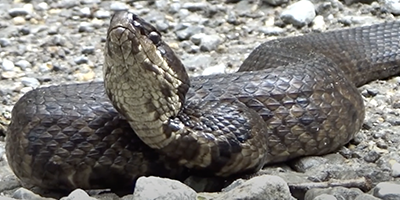 Cottonmouth:
Also known as the Agkistrodon piscivorus leucostoma or the water moccasin, the cottonmouth is a fairly small specimen of the Viperidae family. An adult typically doesn’t grow over 27 inches in length (around 70 cm). Its color tends toward a dark gray or brown and darkens with age, making old cottonmouths appear entirely black. Depending on the darkness of the color, some crossbands may or may not be visible. It gapes its mouth wide when startled, and tends to live near water (e.g. swamps, drainage ditches, lakes).
Cottonmouth:
Also known as the Agkistrodon piscivorus leucostoma or the water moccasin, the cottonmouth is a fairly small specimen of the Viperidae family. An adult typically doesn’t grow over 27 inches in length (around 70 cm). Its color tends toward a dark gray or brown and darkens with age, making old cottonmouths appear entirely black. Depending on the darkness of the color, some crossbands may or may not be visible. It gapes its mouth wide when startled, and tends to live near water (e.g. swamps, drainage ditches, lakes).
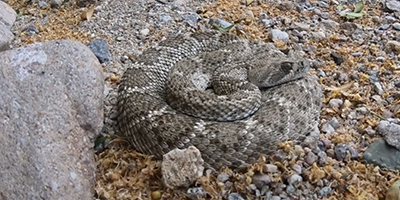 Western Diamondback Rattlesnake:
Scientifically referred to as the Crotalus atrox, the diamondback rattlesnake is a large serpent, typically growing to 4 feet in length (120 cm). Its colors are earthy and tend towards a mottled brown, sometimes darkening all the way to black. Its back is marked by rough, diamond-shaped blotches, hence its name. Although it will issue a warning rattle, the diamondback isn’t afraid of striking. It is, in fact, one of the most aggressive snakes across the U.S. Much of its diet consists of small mammals, and it’s typically encountered in rocky areas.
Western Diamondback Rattlesnake:
Scientifically referred to as the Crotalus atrox, the diamondback rattlesnake is a large serpent, typically growing to 4 feet in length (120 cm). Its colors are earthy and tend towards a mottled brown, sometimes darkening all the way to black. Its back is marked by rough, diamond-shaped blotches, hence its name. Although it will issue a warning rattle, the diamondback isn’t afraid of striking. It is, in fact, one of the most aggressive snakes across the U.S. Much of its diet consists of small mammals, and it’s typically encountered in rocky areas.
If you're unsure, you can email me a photo of the snake at info@littlerocksnakes.com and I will email you back with the snake's species. If you found a snake skin, read my Found a Skin? page, and you can email me a photo of the skin, and I'll identify the snake for you. If you need professional Little Rock snake removal help, click my Get Help page, or see the below website sponsor I found, who provides that service.
Remember, the term is not poisonous snakes of Little Rock, it's venomous snakes of Little Rock. Poison is generally something you eat, and venom is injected into you. That said, dangerous snakes are very rare in Little Rock. The few venomous snakes of Pulaski County are rarely seen. But they are commonly misidentified, so learn about all the snake species of Little Rock in order to correctly identify them. These snakes are usually also found in the surrounding towns of Little Rock, North Little Rock, Jacksonville, Sherwood, Maumelle, Wrightsvill, Cammack Village, College Station, Roland, Sweet Home, Hensley, McAlmont, Woodson, Gravel Ridge, Natural Steps, Gibson, Landmark and the surrounding areas.
Read our article about:
Ways to Determine a Venomous Snake
littlerocksnakes.com domain and hosting costs made possible by the generous support of this sponsor:
